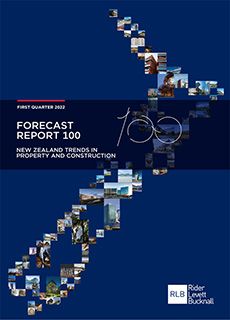Construction demand remains resilient despite impacts of omicron
Rider Levett Bucknall (RLB) is celebrating the 100th issue of the RLB Forecast Report, which has detailed property and construction trends across New Zealand for the past 35 years.
RLB has partnered with the New Zealand Institute of Economic Research (NZIER) to publish the significant 100th edition of Forecast, with the quarterly report initially being published in 1988 – a time when The Right Honourable David Lange was serving as New Zealand’s Prime Minister, and when Del Hogg was the RLB Wellington Managing Director.
According to Rider Levett Bucknall’s (RLB) Forecast 100 report – New Zealand Trends in Property and Construction – despite heightened uncertainty over how the accelerating community transmission of the Omicron variant of COVID-19 will evolve over the coming year, construction demand remains resilient.
Construction ramps up at various degrees due to capacity pressures
Prepared by the New Zealand Institute of Economic Research (Inc.) (NZIER) exclusively for RLB, Forecast 100 stated however that acute capacity pressures in the construction sector will likely constrain the degree to which construction activity ramps up over the coming year.
RLB Director, Mr Grant Watkins said, “The prolonged lockdown in Auckland and some neighbouring regions, along with social distancing restrictions, affected construction activity through to December 2021.
“The effects were both directly through the amount of construction that could take place onsite under lockdown, as well as indirectly through the domestic production of building materials,” he added.
Forecast 100 noted that despite these restrictions’ impact on construction activity, demand remains strong. In particular, the latest consent issuance data showed continued growth in dwelling consent issuance. Infrastructure demand has also been strong, as the government invests to support the New Zealand economic recovery.
Global supply chain disruptions and border restrictions drive surge in costs
Mr Watkins continued, “Whilst the relaxation of restrictions in December 2021 allowed more construction activity to take place, capacity pressures in the construction sector are constraining activity.”
“Global supply chain disruptions are affecting the ability of building sector firms to source materials, while international border restrictions are limiting the ability of firms to bring in workers from overseas to keep up with growing demand. These capacity pressures have driven a surge in construction costs, particularly in residential construction where demand is strongest,” he said.
According to the report, inflation pressures have been rising more broadly. The December 2021 CPI showed annual inflation picking up to 5.9 per cent – well above the Reserve Bank’s 1 to 3 per cent inflation target band. The central bank started increasing the Official Cash Rate (OCR) from its record low of 0.25 per cent in its October meeting, and followed up with another increase in November.
Despite the challenges the outlook remains positive
RLB expects that the Reserve Bank will continue to raise the OCR over the coming years in order to rein in inflation pressures and mitigate the risk of longer-term inflation expectations becoming unanchored.
Mr Watkins concluded, “The property and construction sector’s longer-term outlook remains positive despite the challenges from the continued COVID-19 outbreak. As community transmission of the Omicron COVID-19 variant becomes more widespread, constraints from workers who have to stay home as a result of illness or self-isolation will likely present new supply issues for the construction sector.”
FURTHER INFORMATION:



